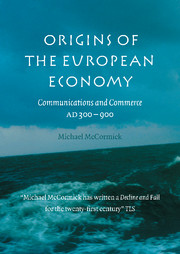Book contents
- Frontmatter
- Dedication
- Contents
- List of maps
- List of figures
- List of tables
- List of charts
- Preface
- List of abbreviations
- Commerce, communications, and the origins of the European economy
- PART I THE END OF THE WORLD
- 1 The end of the ancient world
- 2 Late Roman industry: case studies in decline
- 3 Land and river communications in late antiquity
- 4 Sea change in late antiquity
- The end of the ancient economy: a provisional balance sheet
- PART II PEOPLE ON THE MOVE
- PART III THINGS THAT TRAVELED
- PART IV THE PATTERNS OF CHANGE
- PART V COMMERCE
- Appendices
- Bibliography
- Index
The end of the ancient economy: a provisional balance sheet
from PART I - THE END OF THE WORLD
Published online by Cambridge University Press: 05 February 2015
- Frontmatter
- Dedication
- Contents
- List of maps
- List of figures
- List of tables
- List of charts
- Preface
- List of abbreviations
- Commerce, communications, and the origins of the European economy
- PART I THE END OF THE WORLD
- 1 The end of the ancient world
- 2 Late Roman industry: case studies in decline
- 3 Land and river communications in late antiquity
- 4 Sea change in late antiquity
- The end of the ancient economy: a provisional balance sheet
- PART II PEOPLE ON THE MOVE
- PART III THINGS THAT TRAVELED
- PART IV THE PATTERNS OF CHANGE
- PART V COMMERCE
- Appendices
- Bibliography
- Index
Summary
The economy which had sustained the Roman empire collapsed. It did so through a very long concatenation of gradual deteriorations and sharp blows. Over time, the short-term trend was neither uniform nor unidirectional: the situation improved, sometimes considerably, at various times between c. 250 and 650. But the short-term upswings were not sufficient to redress the long-term trend even when, in some areas, they lasted two or three generations. Certain regions began to decline while others were still, or once again, climbing to new heights of population and the production of wealth. This very disjuncture worked negative consequences on the interaction of different regions of the Roman empire.
The situation in the closing decades of the seventh century was radically different from what had obtained even 160 years earlier. Population and settlement decline had reached the southeastern quadrant of the former Roman world at last. Whether it still continued in the areas where it had first appeared, and how exactly the newcomers, especially the Slavs and Arabs, affected it, is less clear. There is no sign that late antiquity's established or newly virulent infections were abating. In volume, variety, and also geographic range of export, the last pottery shops of Africa were producing on a scale which was but a shadow of their former selves; in the Middle East, others may have been stepping to the fore, but they are, for now, indistinct.
- Type
- Chapter
- Information
- Origins of the European EconomyCommunications and Commerce AD 300–900, pp. 115 - 120Publisher: Cambridge University PressPrint publication year: 2002



